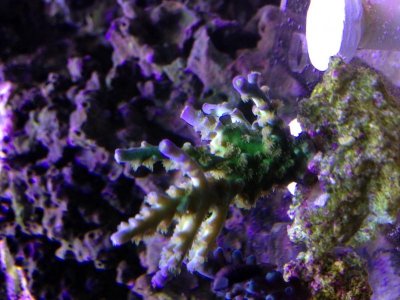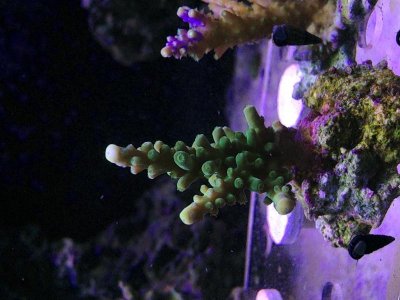First off great thread! Lots of good info here. I started following this thread back in January and have remained silent until I had some results to report.
Second, Joe that is an amazing tank and it is my hope my new tank will be as nice as yours, so I have been taking my time and making changes slowly. I commended your success. Truly amazing!
My tank has varied from 12 to 5 dKH and the color did not change. I do believe that stable alkalinity is a key to colorful coral, but raising alkalinity above that which exists in nature does not change the color of coral of that I am sure.
Joe :beer:
Joe, with respect to your statement above, I have experienced the opposite. I feel that a high Dkh coupled with the intensity of the Radion LEDs did cause my few SPS to loose color.
So I have a couple question with respect to your comment:
1) have you ever ran DKH levels above 11 for a period of 6 months or more?
2) If so what type of lighting were you using? Were you using LEDs?
My results:
On my old system, I ran 250MH, and kept DKh around 7-8. My SPS color was ok, probaly slightly better than average, but I was also some what of a slacker in terms of husbandry, mainly becuase of setup. When I designed this new system (built a new house, so it was easy to make things simple) my #1 goal was SPS color and being able to easily perform tasks. And I have acheieved that. But what killed me is that even though I was doing everything as I thought I should, when I added my first few SPS, color started to fade a couple months later, by December 2012 I was thoroughly frustrated.
My new tank was setup in May of 2012. I added my first SPS corals in September-- a Green monti cap, a very hardy SPS coral and a Valida frag which had amazing color. These pieces were to be my test pieces! And until I knew that color would hold or improve, nothing else was to be added. My Dkh levels were maintained over 10.5 and mostly around 11.5. All my other tests (Ca, Mg, No3, Po4) were in check. But color was fading? That's when I really started researching all that I could find. My conclusion after reading many of the articles by Dana Riddle on AA in conjunction with this thread and many other threads on RC, my DKH had to be reduced and I also probably needed to reduce my photo period. In February I started tracking my result very closely and by March I was seeing color return. I will post a detailed account of what I did, but I feel the two things that I can attribute to my success is reducing my Alk levels and reducing photo period.
I will try and post some pics of the Valida and Green monti. I will also post a detailed accounting of what I did and the test results. The test results will probably lead others to draw different conclusions--mainly that adding I2, Fe and part D red sea reef colors may have helped, but my coral coloration was already recovering well before I started dosing these supplements. Since starting these supplements, they may have helped. I should also note I have a reasonable bio load on the tank which I am relying on to help feed corals. I am not not feeding my corals directly. And I have read all of Borneman's stuff. This tank is striving to be ULNS.
HTH others.
Cheers!
Brett





